The slang and sayings only South Aussies will understand – Part 2
Crossing state lines into SA for the first time? Get across the local lingo in part two of our guide to the slang and phrases only South Australians will understand.

SA News
Don't miss out on the headlines from SA News. Followed categories will be added to My News.
We don’t like to brag, but part one of our guide to unique South Aussie words and phrases went boonta! And we reckon that’s Heaps Good, so we’ve pulled together this bonus guide to the local lingo. If you missed part one, go back and read it here. We’ll have you speaking fluent South Australian in no time.
What did we miss? Post your suggestions in the comments box below.
LAYGO
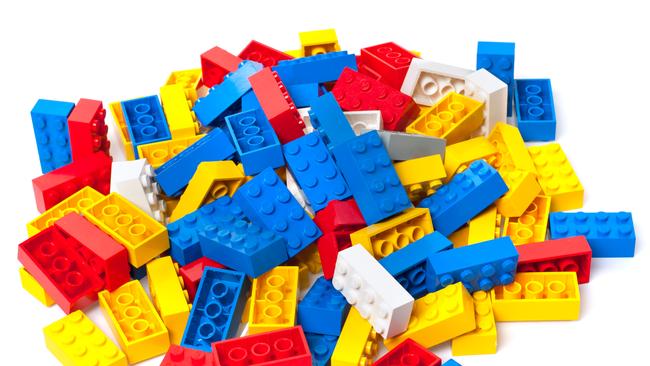
Do you like to darnce around the plarnts in your carssil? If you answered yes to any of these questions, you could be South Australian.
Another sure-fire way to tell if you have South Australianitis is to try pronouncing the name of the world’s most famous Danish plastic connectable brick toy, Lego.
Famously, South Australians tend to pronounce the word as ‘laygo’, while elsewhere in the country the common pronunciation is ‘leggo’. So who’s right? We reached out to Emeritus Professor Roly Sussex from the School of Languages and Cultures at The University of Queensland to help us settle the debate once and for all.
And, umm, well, look it’s complicated. Professor Sussex pointed us to a YouTube video where the word ‘Lego’ is spoken in Danish.
When you hear the word spoken, it sounds more like “leee-go”, in other words, it’s not LAY-GO as it’s pronounced in SA – but it’s not LEG-oh, either.
In other words, the SA pronunciation is not correct because the “ay” part of the word is what’s called a diphthong – “two sounds sliding from one to the other”. Lay-go.
But the eastern states pronunciation is not correct either because, Professor Sussex says “the g in Danish isn’t a g at all, but a weak k”.
As the spelling goes, Prof Sussex says “laygo” would be the closest English translation of the Danish word, but “leggo” would be the way to spell the word, according to the way most people in Australian pronounce it.
“Ceteris paribus (that’s Latin for all things being equal, in case you were wondering) following the homeland language pronunciation is often wise and thoughtful.
“But there is a very wide tendency to say Leggo, which I believe is spread through many English-speaking countries.
“The SA pronunciation, so long as it isn’t a diphthong (lay-go), is certainly closer to the Danish; but if you say that in the Eastern states my impression is that many would not understand at once. We often have to modify our pronunciation in the interests of being understood.”
Damnit. Undone by a diphthong.
So what’s the bottom line? No one in Australia pronounces “Lego” correctly, so we can call an end to those smug jokes from the eastern states now, thank you very much.
How to use it in a sentence: “Mummy, mummy, Francis won’t give me back my laygo!!”.
A BUTCHER OF BEER
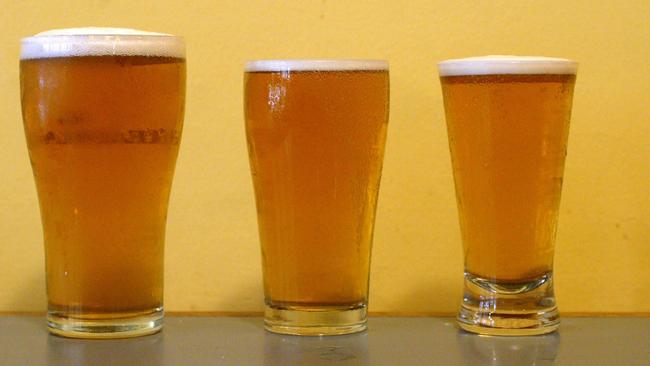
Sure, the Australian Tax Code is pretty complicated, but have you ever tried ordering a beer in Australia? Once you’ve finally decided whether you’d like a lager or an ale, something fruity or something hoppy, made from barley or wheat, your next challenge is to decide what size glass you’d like to drink it from; pint, imperial pint, middy, pot, pony or schooner and what these sizes mean is different in just about every state and territory in the country. Helpful, right?
In that regard, SA has one up on the rest of the country with “the Butcher”, a 200ml (7oz) glass that you’re not likely to find outside these borders. It won’t shock you to learn that the true origins of the name are as murky as a pale ale. But many fantastic theories abound, most of them linked to the Adelaide meat trade.
A common theory is that the term was first coined in the late 1880s by the publican at the Newmarket Hotel, which at the time was near an abattoir, to describe the glasses reserved for the hordes of thirsty, dirty slaughtermen who frequented the place.
A smaller glass, some claim, was preferred “possibly because it wouldn’t slip through their bloodied fingers”. Another theory suggests the term was the name given to the small glasses of beer given to the ‘butcher boys’ who ran around Adelaide delivering meat to the various hotels.
But beer historian Dr Brett Stubbs says there is evidence tracking the use of the term back before 1880, at numerous pubs across the city, and that some accounts actually use the term to describe ‘a long drink of beer’, not a short one. Anyway, Dr Stubbs says there’s another “more believable” explanation for the origins of the term. The word was an anglicised version of the German word for a drinking vessel – ‘becher’.
“Much later, when the true origin of this mysterious beer-drinking term had been forgotten, the elaborate stories about meatworkers were conjured up to explain its existence. So, despite popular belief, the origin of the butcher glass probably has nothing at all to do with meatworkers.”
Let’s call the whole thing off and go get a drink.
How to use it in a sentence: Two butchers, three pints and a schooner, thanks cobber.
KITCHENER BUN
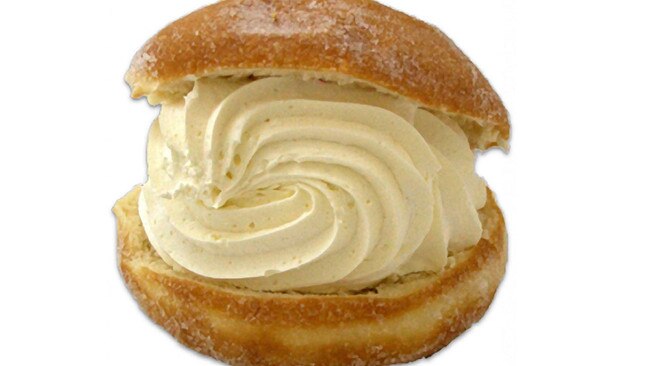
In 2003, when France refused to back the war in Iraq, the United States took its revenge through food. Potatoes, specifically. North Carolina restaurateur Neal Rowland decided one small way he could support his county, and to extend a middle finger to the French, was to change the name of “French” fries on his menu to “freedom” fries. The name, as we know, caught on and soon could be found on menus across the country, including in the cafeteria on Capitol Hill.
South Australia flexed its patriotic muscles in the same way during the First World War, anglicising dozens of town and suburb names that had previously had German ones.
Hahndorf became “Ambleside”, for example, Klemzig “Gaza”, Buchfelde “Loos”, Lobethal “Tweedvale”.
But it wasn’t just with place names that SA set about scrubbing out its German history. We made some changes in the kitchen too, ditching the German bun Berliner and replacing it with the “Kitchener”, in honour of the British military leader Lord Herbert Kitchener.
The new Kitchener bun was pretty close to the Berliner. But where the German version was fully enclosed with a jam filling, the Kitchener, from the early 1930s at least, was served open face with a dollop of jam and lashings of cream.
Speaking of lashings, in 1944, Unley baker Harold Morgan from the Sunshine Home Made Cake Shop got pinched by the government for the heinous crime of using cream in his Kitchener buns on two occasions, in contravention of the National Security (Food Control) Regulations.
He copped a big fine and got named and shamed in the paper. Good one, Harold!
Some sources have listed the arrival of the Kitchener as 1917 but it is found mentioned in this item from a publication called The Searchlight as early as March 24, 1915.
“We notice a new bun advertised here this week. “Kitchener Buns” no less. We hope they’re not as hard and unyielding as their namesake, that’s all”.
Happily the Berliner bun has made its way back into bakery cabinets across SA, but typically with custard or Nutella rather than cream. Which may seem like a problem at first, if you only want to eat one bun. But the Berliner and Kitchener are allies, not enemies so just have one of each. Peace at last.
How to use it in a sentence: “I’ve just eaten two whole Kitchener buns. I regret nothing!”
DOUBLE CUT ROLL
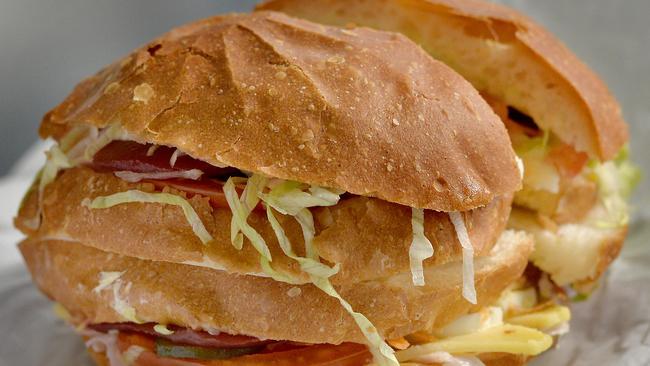
Forget the dual-flush toilet. Bugger Wi-Fi. Surely South Australia’s single greatest invention is the double-cut roll.
For the uneducated, the double-cut roll that may appear to the untrained eye to be a boring garden variety salad roll, but, in fact, is a piece of engineering brilliance. Why? Because it features two layers of delicious sandwich fillings, not one, and basic maths will tell you that two is better than one.
As Gary Lekkas, a correspondent on Bob Byrne’s Adelaide Remember When Facebook page explained, the arrival of the double-cut roll opened up a mind-blowing world of possibilities because – and you may want to make sure you’re sitting down for this bit – “you could have one set of toppings on the top half with something completely different on the bottom.”
Go on, have ham, lettuce, cheese and tomato on the top layer of your awesome double-cut roll and peanut butter and banana on the bottom. Who’s going to stop you? Not me.
It’s difficult to track the precise origins of the double-cut roll, but two things seem reasonably clear – it is predominantly found in SA and dates back to at least the early 1930s and was “commonplace” by 1940.
As a 1931 article in the Adelaide News on declining food prices rejoiced “What with double-cut rolls at threepence, sandwiches the same, and three-course meals a shilling, the epicure is happy again”.
There is also some evidence the double-cut roll was adopted outside our borders with a small item in the News in 1940 under the headline “Heard in Passing” reporting that “the double-cut roll is known in Melbourne as the Adelaide roll”.
The double-cut roll has possibly declined in popularity in recent years, but you can still get your hands on one if you know where to look.
How to use it in a sentence: “Double-cut roll, thanks love. Ham and salad on the bottom, schnitzel and tomato up the top”.
SPOGGY
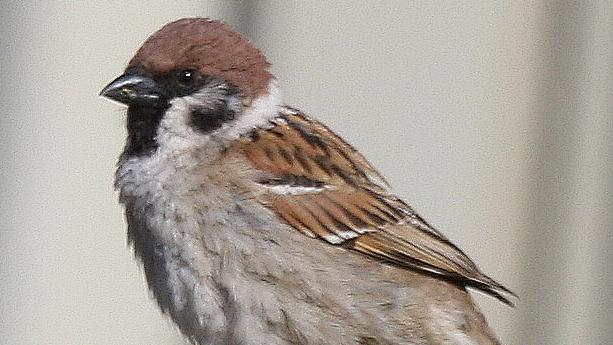
As we all know, in the bird department, South Australians are most commonly associated with Crows – and specifically how much we all love eating them.
(I’m having Crow schnitzels tonight, as it happens).
But turns out we’ve got a long history with the common sparrow – or at least a very old nickname for them. According to an article on Ozwords.org, a blog by the ANU and Oxford University Press, South Australians have been referring to sparrows as “spoggies” since at least the 1890s.
In a very strange column in the Northern Argus, from October 1892, the writer is explaining a conversation between his wife and four-year-old son, Gerogie, in which she is introducing him to the concept of heaven and angels. “Can they fly way up?” little Georgie asks.
“Can they ‘light on the twenty-teety end of a limb an’ eat worms like spoggies (sparrows)?”
The roots of the nickname go back to the motherlands, England and Scotland, where sparrows have variously been referred to in history as “spug”, “spyug”, “spuggy”, “spag”, “spagger”, “sprag”, “spraggie”, “spriggy” and “sprig”.
While at least some of these nicknames have taken root around Australia, you’ll likely only hear the term “spoggy” in the great state of South Australia.
But probably only if you’re talking to your nan and pop – or anyone old enough to still use phrases like “at any rate” and “chains” as a unit of measurement, because the nickname has probably been a bit on the wane in recent generations.
How to use it in a sentence: “I have to be up at a Spoggy’s fart tomorrow”.
FROG CAKE
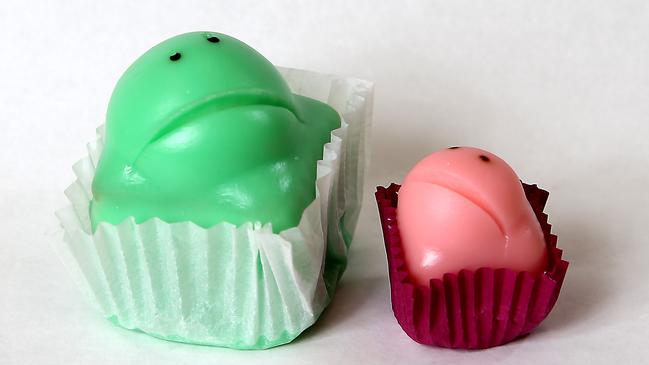
Look, does it look like a real frog? No. Does it look like a frightened doorstop with a gooby face? Yes. Is it a goddamn South Australian treasure? Hell yeah, and don’t you forget it.
The frog cake, a dainty little treat comprising two layers of sponge with jam between them and a knob of buttercream on top under a blanket of fondant, was introduced by Balfour’s in 1922, reportedly after Gordon Balfour, nephew of one of the bakery’s founders, was inspired by the delicious treats he saw on his travels in France.
The original frog cake was green but now comes in pink and brown and has become such a state treasure it was listed as a heritage icon by the National Trust of SA in 2001.
It also has fans in high places.
In 2014 during their blockbuster performance at the new Adelaide Oval, Rolling Stones frontman Mick Jagger revealed that during their visit Keith had enjoyed a pie floater “and Charlie’s had a frog cake”. We’re not sure if he enjoyed it but we heard he ended up with sticky fingers.
How to use it in a sentence: “Oi, Mick, get us another frog cake would ya?”.
DICKEN
Just imagine how Chips Rafferty or Jack Thompson’s characters in the film Wake in Fright would react if you tried to spin them a tall tale.
Now swap out all the F bombs with “dicken” and you’ll start to get a sense of how this peculiar South Australian-ism has been used in everyday conversation.
You might also think about it alongside phrases like “Come off it”, “get away” or “piss off”.
According to Dorothy Jauncy from the Australian National Dictionary Centre in her 2004 book “Bardi Grubs and Frog Cakes, South Australian Words”, the term “dicken” was generally used to express disgust or disbelief and comes from the British term “dickens”, as in what/why/where/how. in the dickens.
She says the term was first recorded in Australia in 1894 and was also used in New Zealand.
“Its use has been infrequent since the mid 1960s, and appears to have been restricted mostly to South Australia”. Who knows why. Perhaps because South Australians are just more refined than their interstate brethren.
How to use it in a sentence: “He drank 10 butchers of beer in 10 minutes? Dicken!”
CHECKSIDE PUNT

The Vics like to think of themselves as the sole custodians of the great sport of Aussie Rules football. But the fact is, at least some of the greatest features of the game – not to mention some of the greatest players – have come from South Australia.
One of those innovations includes the art of kicking a miracle goal from an impossible angle from the right forward pocket, generally known as the ‘checkside punt’.
As Peter Cornwall writes in a detailed history of the kick, the precise origins of the checkside are somewhat contested but all signs point to it being a South Australian invention.
“There is such a parochial pride in it, every time football aficionados from Victoria get it wrong – no, the banana kick is not the same, it is booted from the opposite pocket – Croweaters like Graham Cornes, Dwayne Russell and McAvaney are at pains to correct it.”
According to Cornwall, and in response to claims by the Victorians that they had invented the kick, respected Advertiser football writer Harry Kneebone weighed into the debate in 1959 to report that the first player he ever saw “deliberately” use the technique – which he called ‘the reverse swing punt’ or ‘reverse screw punt’ was Glenelg’s Colin Churchett, a champion goalkicker from the 1940s and fifties.
We know for sure that West Torrens legend Lindsay Head mastered the kick in the 1950s – The Advertiser published a series of three photos of Head demonstrating his technique in 1959.
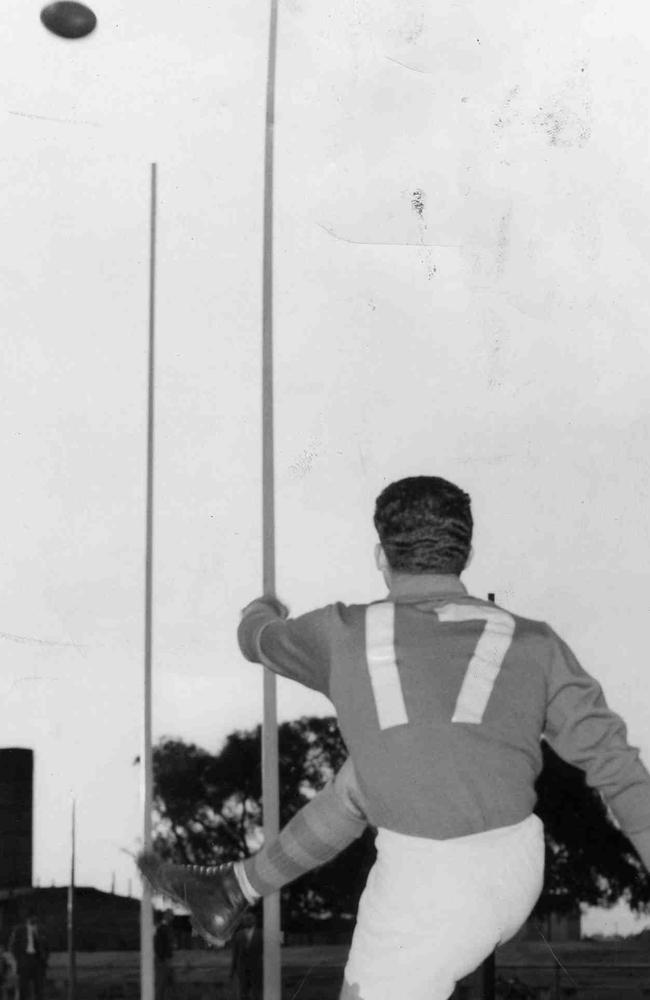
As Cornwall points out, whether a similar kick had ever been practised in Victoria, it was at the very least an “oddity”. So much so that Victorian researchers made a special trip to Adelaide to study Head’s technique intensively, measuring the curl of the kick and recording it in slow-motion.
Head was asked if he knew of any Melbourne players who were using the checkside and replied “if someone was doing it in Victoria they wouldn’t have sent the team over here”.
Good point, well made.
In later years, Sturt legend Jack Oatey, Cornwall writes, became the first coach to train his players how to master the kick, which, according to his son Robert, he called “backscrewies”.
Whatever you called it, Oatey’s use of the kick as a team strategy appears to have paid off, with rover-small forward Peter Endersbee kicking a bag of miraculous goals from the boundary in the 1968 grand final against Port Adelaide, cementing the kick, which was listed by the National Trust of SA in 2002 as a heritage icon.
And an enduring contribution to the national game.




